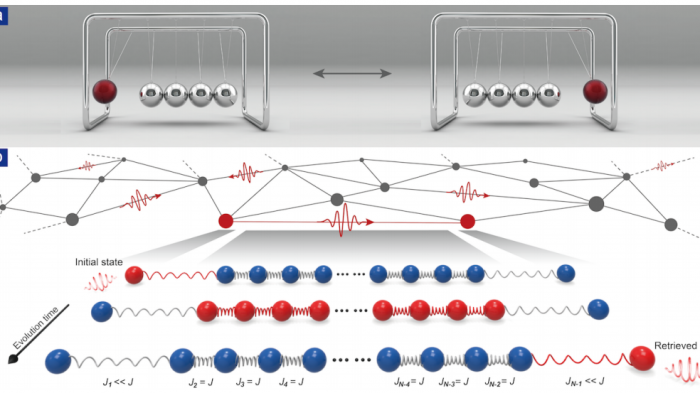How a Newton’s cradle for photons could reveal the secrets of photosynthesis

One popular device for demonstrating the conservation of energy and momentum is Newton’s cradle—a series of suspended balls in contact with each other. The device in its modern form was probably devised in the 1960s and then sold as an office toy. But Newton, and various others in the 17th century, were well versed in its physics.
These principles have universal application. They apply as well on the cosmological scale as they do on the human scale. They also apply on the atomic and subatomic scale, albeit modified by the strange laws of quantum mechanics.
And that raises an interesting question: is it possible to build the quantum equivalent of a Newton’s cradle using subatomic particles, such as photons?

Today we get an answer thanks to the work of Zhen Feng at Shanghai Jiao Tong University in China and a group of colleagues. These physicists have created a Newton’s cradle out of photons and say the physics involved could help explain a range of poorly understood energy transfer processes in nature, such as photosynthesis and odor sensing.
A Newton’s cradle is a simple device. A demonstration begins by lifting and dropping the ball at one end of the suspended series. When this ball collides with the next in line, it transfers its energy and momentum. The second ball then transfers its energy and momentum to the next ball and so on, until the last ball is is propelled into the air. It swings away and then back, at which point the process of energy and momentum transfer repeats in the opposite direction.
The beauty of the device is that energy and momentum transfer do not need to be controlled at each step. Instead, the device is engineered in a way that ensures the transfer occurs by itself. The only influence the experimenter has is on the boundary condition—the height that the first ball is raised.
The question that Zhen and co investigate is whether a similar system can be engineered to work with photons. Their equivalent of the “cradle” is a series of waveguides carved into a photonic chip. A photon enters the first waveguide, then jumps to the next, and so on, until it emerges from the last waveguide. In total, there are 23 waveguides in this chain.
Crucially, the photon must retain its quantum “identity” during each jump. So there can be no decoherence: the photon that emerges must be recognizably the same as the one that entered the apparatus
A key factor is the coupling between the waveguides. This governs whether the photon can make the jump successfully or is reflected or absorbed.
So the way the photonic chip is engineered is crucial. Indeed, Zhen and co perfected their design so there is no need to control each jump—it just occurs in the same way as the energy transfers from ball to ball in a Newton’s cradle. “The chain is able to transfer energy between two remote sites with the same fashion of energy exchange and interaction mechanics of Newton’s cradle,” say Zhen and co.
The team also introduce noise into the cradle to see how it reduces the transfer efficiency. They do this by adding an additional waveguide—an island site—next to the chain. This appears as a dead end for photons and would seem to prevent or reduce the energy transfer. “The newly added island site can be considered as noise, defect or environment for the original boundary-controlled chain,” say the researchers.
But counterintuitively, the opposite happens. Zhen and co show that there are a wide range of conditions in which this “noise” improves the transmission efficiency instead of reducing it: “We can obtain an increase of 8% from 77% (without defect) to 85% (with defect).”
That has some similarities with observations of energy transfer in living things. It turns out that photosynthetic systems behave in a similar way. Various research groups have noticed that defects seem to enhance the energy transfer across the giant molecular structures involved in photosynthesis. A similar effect occurs in odor sensing, which is widely thought to be a quantum phenomenon.
Being able to reproduce this puzzling effect in an artificial system will allow researchers to study it in more detail. Indeed, the photonic Newton’s cradle is set to become a useful model for better understanding the processes of life. Newton would have been amazed.
Ref: arxiv.org/abs/1901.07574 : Photonic Newton’s Cradle for Remote Energy Transport
Keep Reading
Most Popular
Large language models can do jaw-dropping things. But nobody knows exactly why.
And that's a problem. Figuring it out is one of the biggest scientific puzzles of our time and a crucial step towards controlling more powerful future models.
The problem with plug-in hybrids? Their drivers.
Plug-in hybrids are often sold as a transition to EVs, but new data from Europe shows we’re still underestimating the emissions they produce.
Google DeepMind’s new generative model makes Super Mario–like games from scratch
Genie learns how to control games by watching hours and hours of video. It could help train next-gen robots too.
How scientists traced a mysterious covid case back to six toilets
When wastewater surveillance turns into a hunt for a single infected individual, the ethics get tricky.
Stay connected
Get the latest updates from
MIT Technology Review
Discover special offers, top stories, upcoming events, and more.